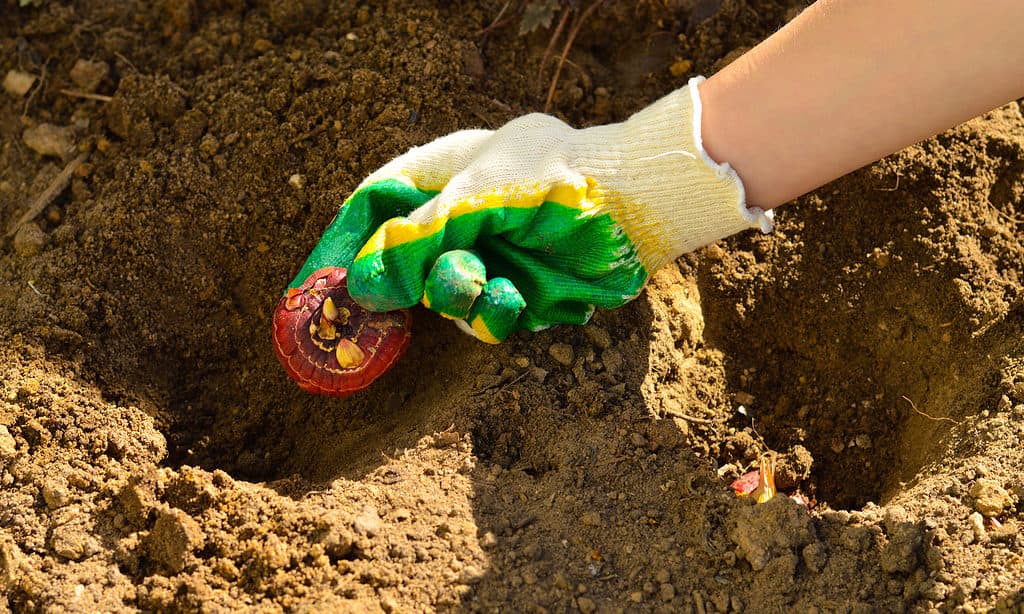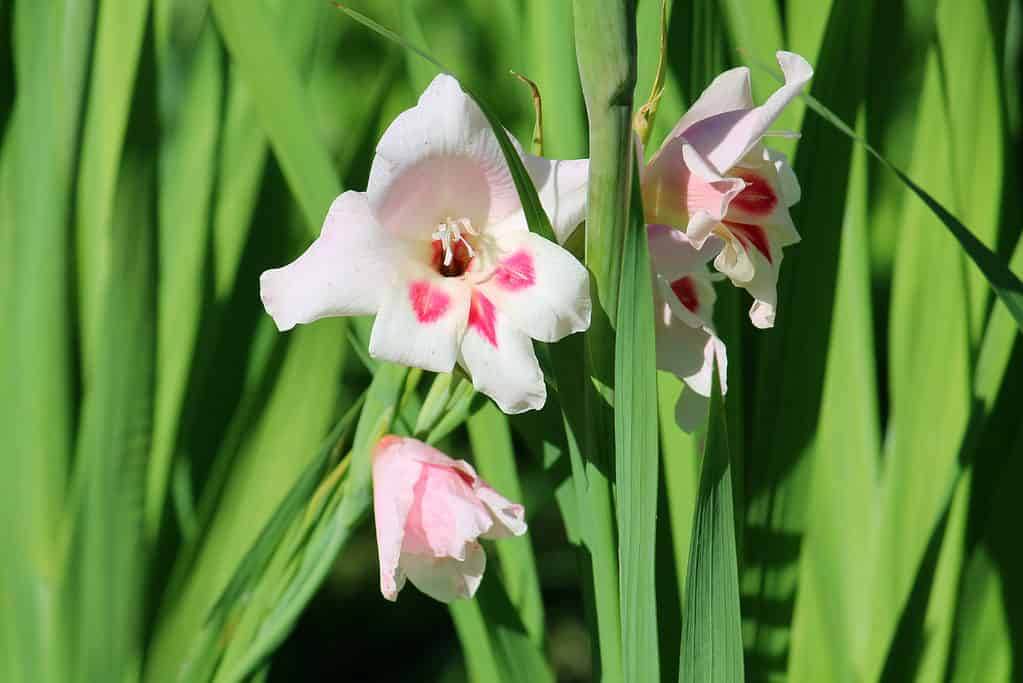Whether you’re growing them competitively for exhibitions or as a hobby at home to brighten up your yard, the Gladiolus is a wonderful bulb to cultivate this spring. Their plentiful blooms come in a complete range of colors and are prized cut flowers, singly or in bouquets. Although they have their origin in the warmer climes of the Southern Hemisphere, gladiolus bulbs are hardy and grow perennially in a surprisingly wide range of more temperate climates. They are a wonderful addition to any garden.
| Botanical Name | Gladiolus sp. |
| Popular Options | Gladiolus sp. ‘Red Cascade’; Gladiolus sp. ‘Impressive’; Gladiolus sp. ‘Las Vegas’ |
| Sunlight | Plant in full sun for best blooms. Will tolerate some shade. |
| Water | Keep soil moist throughout the season. Do not allow the soil to dry out. Avoid and prevent standing water. |
| Soil | Sandy, is well-draining, and rich in organic material. Clay soils must be amended. |
| Hardiness | Generally hardy down to USDA Zone 5. Can vary depending on chosen cultivar. |
| Beginner Friendly? | Yes, they are considered easy to grow. |

blooms come in a complete range of colors and are prized cut flowers, singly or in bouquets.
©iStock.com/Jareck
What is a Gladiolus Bulb?
Did you know that the term “gladiolus bulb” is technically a misnomer? These eye-catchers are members of the iris family, Iridaceae, and produce what is called a corm. This stout underground portion of the stem is similar to a bulb. It is used to store nutrients for the plant throughout its dormant period. It is different, however, in its overall structure.
The main distinction between corms and bulbs lies in which part of the plant is used as the nutrient store. In cormous plants, the stem itself is upright and swollen at the base, just above the basal plate where the roots are attached. It is this swollen portion of the stem that is filled with the storage tissues that hold the starch that the plant produces over the growing season. When the temperatures change and the plant goes dormant, it uses the food in its corm to maintain itself until the spring. At this point, the previous season’s corm is exhausted in the production of new growth. Another corm is generated for use throughout the rest of the year.
True bulbs also have a basal root plate, but instead store their nutrients in fleshy leaves which surround a central, specialized bud from which the plant produces its above-ground parts. Examples of true bulbs include hyacinths, garlic, and onions.

produces corms for nutrient storage, which are similar to a bulb but structurally different.
©iStock.com/svf74
What Options Are There?
Your search online for Gladiolus bulbs is sure to turn up a plethora of attractive options for your garden. There are many popular garden cultivars of gladioli. Most originate from the various crosses of about 8 different wild species hailing from multiple continents. Due to the use of different naming conventions and their complicated lineage, it is often difficult to identify exactly which species each gladiolus cultivar belongs to.
While the sword-shaped foliage of their namesake remains the same across the board, the widespread popularity of the gladiolus has resulted in a broad range of cultivars that produce blooms across the color spectrum. These modern hybrids can be sorted into three main groups of gladioli that are differentiated by the sizes and shapes of the flowers produced by each cultivar.
Grandiflora Hybrids
This group of Gladiolus is characterized by the large stature of its members, which can grow to heights of 4-6 feet. Their height relative to the strength of their stems may require that they be supported with stakes to prevent them from breaking. Although their stems can be fragile, cultivars in this group tend to produce impressive quantities of large blooms (technically referred to as “spikes”) and are popular exhibition entries.
In the spring, once there is no more chance of frost, your Gladiolus “bulbs” should be planted in the garden bed about 4 inches deep and spaced about 6 inches apart. Like true bulbs, your Gladiolus corms must be planted with their pointed end facing up. If your garden is particularly sandy, you should turn some compost or well-rotted manure into the soil at your planting site.
During their blooming period in the summer, it is important to keep these plants watered so that they have all the resources they need to produce their plentiful flowers. Well-draining soil is especially important when growing any Gladiolus. Standing water will weaken your plant. It will also prevent its roots from receiving the oxygen they need, causing crown rot, root rot, or both.
Some gorgeous grandiflora cultivars you may want to consider include:
- Gladiolus sp. ‘Lumiere’
- Gladiolus sp. ‘Mon Amour’
- Gladiolus sp. ‘Black Star’

Your Gladiolus corms must be planted with their pointed end facing up.
©iStock.com/Irina Starikova
Nanus Hybrids
In stark contrast to its grandiflora relatives, these Gladiolus cultivars are diminutive in size. They produce stems between 12-18 inches in length. Cultivars in this group are generally considered easy to grow. Some are even cold and hardy down to USDA Zone 5.
When planting in the spring, be sure that they are placed about 4 inches deep in the well-draining, sandy soil of a sunny garden bed. Due to their smaller size, their stalks tend to be sturdier. Their lower center of gravity makes them better candidates for container planting than members of the grandiflora class. In the garden bed, they are commonly planted in small groups in the foreground or in tight corners to maximize the impact of their more loosely spaced flowers.
Regardless of where you plant them, you must make sure that they receive 6-8 hours of full sun throughout the day. Give them enough water to keep their soil moist. It is important to remember that your plants are not only growing beautiful flowers, but they are also working hard to produce enough food to last them through their dormant period and into the following spring.
If this group sounds like a good fit for your garden, you may want to purchase corms of these Gladiolus nanus cultivars:
- Gladiolus sp. ‘Charming Beauty
- Gladiolus sp. ‘Halley’
- Gladiolus sp. ‘Impressive’

cultivars are typically diminutive in size, producing stems between 12-18 inches in length.
©iStock.com/kazakovmaksim
Primulinus Hybrids
A more difficult grouping to pin down, the group of gladioli often referred to as the primulinus hybrids are made up of cultivars created in the 19th century through the breeding of a wild species of Gladiolus (now referred to as Gladiolus dalenii) with large-flowered forms already in cultivation. They feature distinct, often variegated blooms, which are usually nodding, hooded, or both. They are less densely packed than plants of the grandiflora group. Taking up the middle ground in terms of size, they tend to produce stems that measure 2-4 feet in height. Like the nanus cultivars, certain members of this group can be winter hardy down to USDA Zone 5. There can be wide variance between cultivars. Be sure that you choose one suited to your growing methods and climate.
Some flashy, variegated examples of primulinus hybrids are as follows:
- Gladiolus sp. ‘Las Vegas’
- Gladiolus sp. ‘Atomic’
- Gladiolus sp. ‘Carolina Primrose’
How to Overwinter Gladiolus “Bulbs”
No matter where you are, it is important to take care that your spring Gladiolus plants are overwintered properly if you expect them to reappear in the following seasons. Once flowering has ceased towards the end of summer and the beginning of fall, it is time to get your plants ready for dormancy.
If you live in USDA Zones 8-10, leave your corms in the ground and cover them with 2-4 inches of straw mulch to shelter them through their dormancy. While this is not always necessary, it can help insulate the soil against frost and cooler-than-normal temperatures. It is important to note that in their native habitat, these dormant corms would expect to see a significant decrease in rainfall. Therefore, the watering of your plants should cease until the return of spring.
For those that reside in cooler zones, or for anyone who expects their area to experience a hard freeze, end-of-season care is a bit more complicated. Rather than leave corms in the ground, they should carefully dig them up, and their remaining foliage snipped back. At this point, brush them off and place them in a breathable bag or basket in a cool, dry area such as a garage or shed. Wherever you choose to store your corms as they dry out for the winter, ensure the temperature stays between 35-45 degrees Fahrenheit.
How to Propagate Gladiolus “Bulbs”
When digging up your gladioli at the end of the season, you will probably notice what looks like many small corms at the base of your plant. These mini corms, aptly named “cormlets”, are the offspring of your plant. You can carefully detach them and store them with the mature corm for planting during the following season.
The photo featured at the top of this post is © iStock.com/Olga Niekrasova
Sources
- University of Missouri , Available here: https://extension.missouri.edu/publications/g6620
- Integrated Taxonomic Information System , Available here: https://www.itis.gov/servlet/SingleRpt/SingleRpt?search_topic=TSN&search_value=43293#null
- Missouri Botantical Garden, Available here: https://www.missouribotanicalgarden.org/PlantFinder/PlantFinderDetails.aspx?taxonid=264598&isprofile=0&
- PennState Extension, Available here: https://extension.psu.edu/programs/master-gardener/counties/chester/how-to-gardening-brochures/bulbs-corms-rhizomes-and-tubers
- University of Florida Gardening Solutions, Available here: https://gardeningsolutions.ifas.ufl.edu/plants/ornamentals/is-this-a-bulb.html
- Almanac, Available here: https://www.almanac.com/plant/gladiolus
- Pacific Bulb Society, Available here: https://www.pacificbulbsociety.org/pbswiki/index.php/Gladiolus
Thank you for reading! Have some feedback for us? Contact the AZ Animals editorial team.






